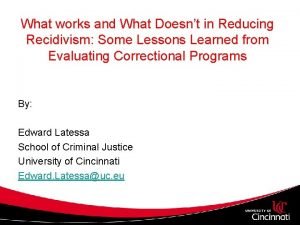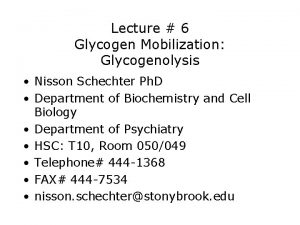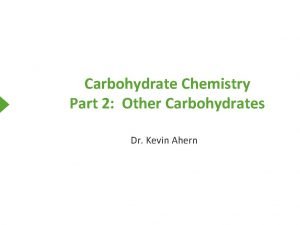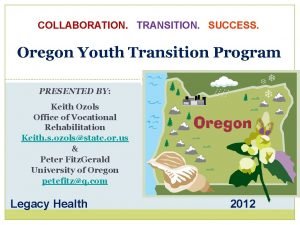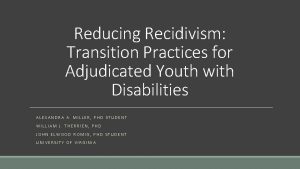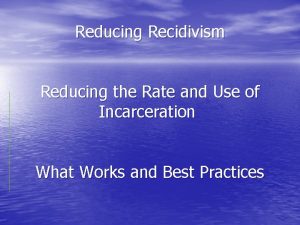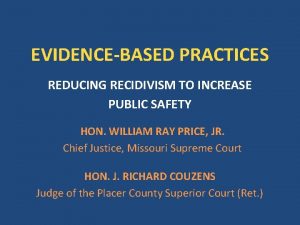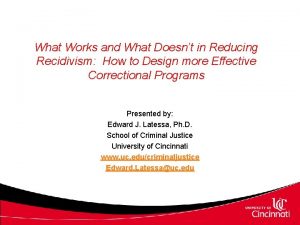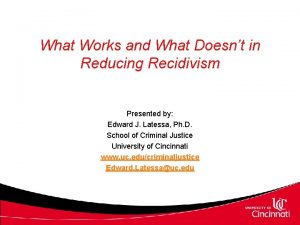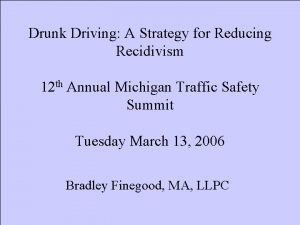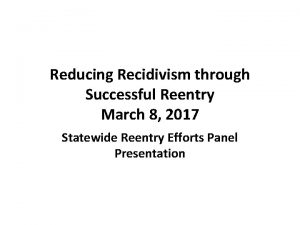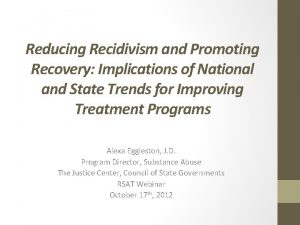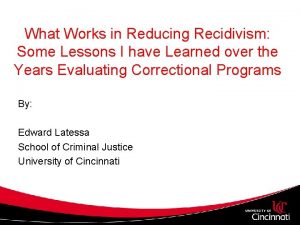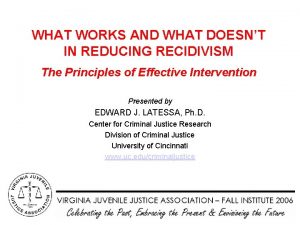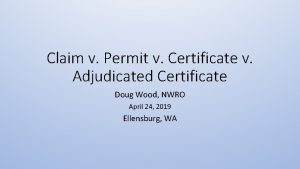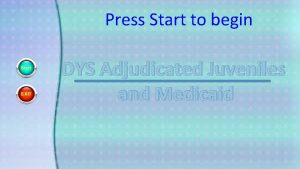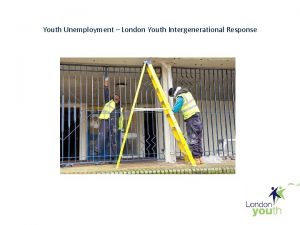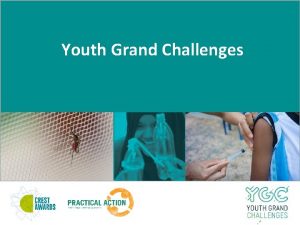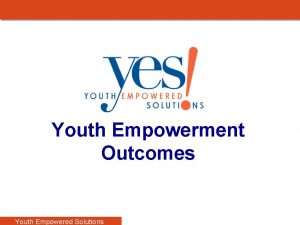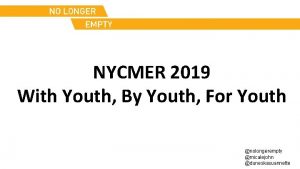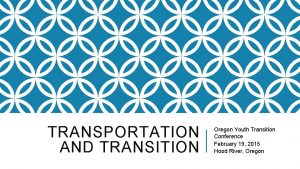Reducing Recidivism Transition Practices for Adjudicated Youth with






























- Slides: 30

Reducing Recidivism: Transition Practices for Adjudicated Youth with Disabilities ALEXANDRA A. MILLER, PHD STUDENT WILLIAM J. THERRIEN, PHD JOHN ELWOOD ROMIG, PHD STUDENT UNIVERSITY OF VIRGINIA

Presentation Overview • Background and Significance • Purpose of the Review • Methods • Results • Discussion • Limitations • Conclusion

A Changing Agenda Juvenile Justice System (JJS) Rehabilitation Protection Punitive “Transition programs have been the most neglected element of correctional education efforts. Transition support is important for all incarcerated persons, but particularly so for the handicapped offender. ” (Rutherford, Nelson, & Wolford, 1985, p. 68)

Consequences of Delinquency Return to School Return to Secure Facility 3 x more likely to enter prison Return Do not return (Sweeten, Bushway, & Paternoster, 2009) Return Do not return (Mears & Travis, 2004)

Youth with Disabilities and JJS Public School Students with Disabilities Individuals without disabilities Individuals with disabilities (United States Department of Education [USDOE], 2014) Students in the JJS with Disabilities Individuals without disabilities Individuals with disabilites (Mallett, 2009; Quinn, Rutherford, Leone, Osher, & Poirer, 2005)

Common Characteristics of Youth in JJS ◦ High rates of school mobility (Malmgren & Meisel, 2004) ◦ Learning disabilities (LD; Mallett, 2009; Quinn et al. , 2005) ◦ Emotional/behavioral disorders (EBD; Mallett, 2009; Quinn et al. , 2005) Characteristics of Youth with EBD ◦ ◦ Highest dropout rate among students with disabilities (American Psychological Association, 2012) Externalizing behaviors such as defiance, aggression, and running away (Malmgren & Meisel, 2004) Histories of abuse, neglect, and experience with the child welfare system (Malmgren & Meisel, 2004) 41% less likely to earn grade promotion and 61% less likely to earn a diploma or GED in secure custody compared to peers without disabilities (Cavendish, 2014)

Importance of Engagement Bullis, Yovanoff, Mueller, & Havel (2002) 531 youth released from secure custody (58% had disabilities) ◦ As compared to youth without disabilities, individuals with disabilities were : ◦ More than 2 x less likely to be engaged ◦ Almost 3 x more likely to return to the justice system within 6 months However… ◦ Youth with disabilities who were engaged at 6 months were close to 4 x more likely to remain engaged at 1 year and 2. 5 x less likely to return to the justice system than their peers with disabilities who were not engaged at 6 months

Regulations on Transition Services Every Student Succeeds Act (ESSA; 2015) o Responsibility of the justice system to guide reentry towards education or employment o Prevent at-risk youth from dropping out of school Individuals with Disabilities Education Act (IDEA; 2004) o Attainable educational and vocational goals supported by an individual transition plan Adherence to Regulations in JJS o 8 states report offering equal educational and vocational opportunities to incarcerated youth o ¼ of states examine student outcome data to determine if youth with special needs are attaining academic and employment skills necessary for transition o Juvenile justice facilities in 20 states report youth enrollment in public school after release o 17 states collect enrollment information for GED programs o 13 states collect data on job training programs enrollment (Council of State Governments [CSG], 2015)

Purpose Research Questions 1. What populations of individuals with disabilities are represented in transition practices studies? 2. What practices have been studied in juvenile detention and/or correctional facilities that assist in transitioning youth with disabilities back into their communities? 3. Which practices are associated with lowering rates of recidivism? 4. Which practices are associated with increased community engagement? 5. Are certain practices more effective for particular populations, specifically EBD?

Methods Search and Inclusion Procedures o. Peer-reviewed, published between 1985 -2016, written in English, and conducted in the U. S. o. Electronic Search o Databases: Academic Search Complete (465 results), Psyc. INFO (291 results), and Eric. Pro. Quest (24 results) o Key words: “juvenile, ” “delinquency, ” “transition, ” “reentry, ” “intervention, ” and “disabilities” o. Ancestral Searches o We conducted ancestral searches with articles identified from the electronic search o. Hand Searches o Journals: Behavioral Disorders, Journal of Correctional Education, Journal of Emotional and Behavioral Disorders, and Youth Violence and Juvenile Justice

Electronic Search 780 total results Methods Search & Inclusion Procedures 57 articles selected for general relevance Title and Abstract Review 57 articles reviewed 21 articles selected Ancestral and Hand Search Ancestral review of 21 articles Hand search of 4 journals 27 additional articles selected 48 total articles to consider Final Review with Narrowed Criteria 48 articles reviewed 7 articles accepted

Results Articles o Black, Brush, Grow, Hawes, Henry, & Hinkle (1996) o Brier (1994) o Griller Clark, Mathur, & Helding (2011) o Hagner, Malloy, Mazzone, & Cormier (2008) o Karcz (1996) o Unruh, Gau, & Waintrup (2009) o Weisz, Walter, Weiss, Fernandez, & Mikow (1990) Independent Coding o Authors, year, sample characteristics, independent variable, method, and results o 95% intercoder reliability

Authors Participants Design IV DV Black et al. (1996) N=207 n SPED=55 Correlational TS AVP Recidivism Community engagement Brier (1994) N=192 Quasi-experimental AVP MHPS Recidivism Griller Clark et al. (2011) N=144 Quasi-experimental TS Recidivism Hagner et al. (2008) N=33 Descriptive TS AVP Recidivism Community engagement Karcz (1996) N=88 Experimental TS Community engagement Unruh et al. (2009) N=320 Quasi-experimental TS Recidivism Community engagement Weisz et al. (1990) N=168 Quasi-experimental TS MHPS Recidivism Summary of Articles TS = Transition Specialist AVP = Academic and Vocational Programming MHPS = Mental Health and Psychosocial Services

Represented Populations General Sample Characteristics o Black et al. (1996) included individuals with and without disabilities o 6 studies focused solely on youth with disabilities o N = 1, 152 Who Is Included o All but 152 participants reported as having a disability or being at-risk o EBD and/or LD: n=401 (35% of total N) o Psychiatric diagnosis: n=294 (26% of total N) o Psychiatric and EBD or LD: n=189 (16% of total N) o Other disabilities (unspecified): n=116 (10% of total N)

Transition Practices 1 2 3 Transition Specialists Academic and Vocational Programming Mental Health and Psychosocial Services • Black et al. (1996)* • Hagner et al. (2008)* • Karcz (1996) • Griller Clark et al. (2011) • Unruh et al. (2009) • Weisz et al. (1990)* • Black et al. (1996)* • Hagner et al. (2008)* • Brier (1994)* • Weisz et al. (1990)* *Used more than one practice

Practice: Transition Specialist (TS) General description: The TS acts as a liaison between youth, the residential facility, and the community who identifies and coordinates services that are appropriate for individuals while detained and those that would be beneficial once released. Coordinated sped and vocational programming within 3 mo. post-release (Youth Reentry Karcz (1996) Specialist) • Recidivism: Not reported • Community engagement: 76% probability of successful enrollment (overall) by 3 months post-release Created transition plans, coordinated outside Griller Clark et al. services, and compiled portfolios (2011) (Enhanced Transition Model) • Recidivism: Treatment 64% less likely to recidivate • 3 months post-release: 34% of treatment did not recidivate vs. 13% nontreatment • Community engagement: Not reported Created transition plans, coordinated pre- and post -release services with ongoing support via Unruh et al. (2009) interagency collaboration (Project SUPPORT) • Recidivism: 62% had not recidivated by 36 month follow-up • Community engagement: Not reported

Practice: TS with Additional Component General description: TS coordinates specific academic, vocational, and/or mental health programs used during (and often after) residential placement Black et al. (1996) TS coordinated GED and vocational programing during detainment; youth earned certificates • Recidivism: 76% overall had not recidivated at 6 months • 71% of sped subgroup had not recidivated at 6 mo. • Community engagement: 53% overall sample engaged (23% not engaged) • 52% of sped subgroup engaged (20% not engaged) TS coordinated pre- and post-release programming Hagner et al. (2008) including high school, GED, & career prep, and mentoring (Nashua Youth Reentry Project) • Recidivism: Of those in community for 3 years, 87% had not recidivated • Community engagement: 67% engaged at 3 year follow-up • 74% of participants who had not recidivated were employed at 3 years TS selected programing for youth from 20 available mental health services that began during residential Weisz et al. (1990) placement and extended post-release (Willie M. Program) • Recidivism: 67% of short cert group and 75% of long cert group had not recidivated at 2 years • Community engagement: Not reported

Practice: Academic, Career, & Mental Health Programming General description: Group or individualized programs that help youth earn school credits, get a GED, explore and pursue career interests, and build on skill deficits in academic, social, mental and behavioral health domains Small group (4 -8) academic, vocational, and psychosocial programs used to Brier (1994) increase specific skills in each area • Recidivism: 88% of Completed group did not recidivate (avg. 20 month follow-up) • 60% of Noncompleted group did not recidivate • 62% of Matched group did not recidivate • Community engagement: Not reported

Discussion Transition Specialists: Key Components Individualization o. Youth involvement (Griller Clark et al. , 2011; Hagner et al. , 2008; Unruh et al. , 2009) o. Pre & post-placement considerations (Hagner et al. , 2008; Unruh et al. , 2009; Weisz et al. , 1990) Interagency collaboration o. Extended support for one year (Bullis et al. , 2002; Unruh et al. , 2009) o. Follow-up

Discussion Transition Specialist: Current Status Nearly 50% of states report that “no single government agency is responsible for ensuring that incarcerated youth transition successfully to an educational or vocational setting” (CSG Justice Center, 2015, p. 11). Only 1/5 of states utilize transition specialists (CSG Justice Center, 2015)

Discussion Academic and Vocational Programming: Key Components Alternative Education Programming o Lower drop-out risk (Farn & Adams, 2016; Hagner et al. , 2008) o GED preparation (Hagner et al. , 2008; Leone, Meisel, & Drakeford, 2002) o Community-based options for credit (Hagner et al. , 2008) Employment Support o Vocational certifications (Black et al. , 2008; Griller Clark et al. , 2011) o Opportunities to explore interests (Hagner et al. , 2008; Unruh et al. , 2009) o Explicit instruction of appropriate work behavior (Brier, 1994)

Discussion Academic and Vocational Programming: Current Status Only 13 states offer opportunities for educational services to youth offenders that are otherwise available to non-adjudicated youth. This includes “credit recovery programs, GED preparation, and postsecondary courses” (CSG Justice Center, 2015, p. 3). Just 9 states provide equal access to vocational services “including workbased learning opportunities, career and technical education courses, and the opportunity to earn vocational certifications” (CSG Justice Center, 2015, p. 3).

Discussion Mental Health and Psychosocial Services: Key Components Multiple Formats o Individual programming (Weisz et al. , 1990) o Group sessions (Brier, 1994) Length of Services o Longer lengths of participation produce promising results (Brier, 1994; Weisz et al. 1990) o Extension of services after release (Weisz et al. , 1990)

Limitations o. Small N o. Long-term effects unknown o. Confirmation of findings o. Influence of other characteristics o. Analysis remains at a macro level

Conclusion o. Availability of academic, vocational, and mental health programming o. Focus on the individual, not prescriptive programming o. Pre- and post-release service coordination o. Extension of services

References American Psychological Association (2012). Facing the school dropout dilemma. Washington, DC: Author. Retrieved from http: //www. apa. org/pi/families/resources/school-dropout-prevention. aspx Baltodano, H. M. , Mathur, S. R. , & Rutherford, R. B. (2005). Transition of incarcerated youth with disabilities across systems and into adulthood. Exceptionality, 13(2), 103 -124. Baltodano, H. M. , Platt, D. , & Roberts, C. W. (2005). Transition from secure care to the community: Significant issues for youth in detention. Journal of Correctional Education, 372 -388. *Black, T. H. , Brush, M. M. , Grow, T. S. , Hawes, J. H. , Henry, D. S. , & Hinkle Jr. , R. W. (1996). Natural Bridge transition program follow-up study. Journal of Correctional Education, 4 -12. Blomberg, T. G. , Bales, W. D. , Mann, K. , Piquero, A. R. , & Berk, R. A. (2011). Incarceration, education and transition from delinquency. Journal of Criminal Justice, 39(4), 355 -365. doi: 10. 1016/j. jcrimjus. 2011. 04. 003 *Brier, N. (1994). Targeted treatment for adjudicated youth with learning disabilities: Effects on recidivism. Journal of Learning Disabilities, 27(4), 215 -222. Bullis, M. , Yovanoff, P. , Mueller, G. , & Havel, E. (2002). Life on the “outs” – Examination of the facility-tocommunity transition of incarcerated youth. Exceptional Children, 69(1), 7 -22. doi: 10. 1177/00144/0290206900101 Cavendish, W. (2014). Academic attainment during commitment and postrelease education-related outcomes of juvenile justice-involved youth with and without disorders. Journal of Emotional and Behavioral Disorders, 22(1), 41 -52. doi: 10. 1177/1063426612470516

References Council of State Governments Justice Center (2015). Locked out: Improving educational and vocational outcomes for incarcerated youth. New York: CSG Justice Center. Every Student Succeeds Act [ESSA], Pub. L. No. 114 -95 § 114 Stat. 1401 (2015 -2016) Farn, A. & Adams, J. (2016). Education and interagency collaboration: A lifeline for justice involved youth. Washington, DC: Center for Juvenile Justice Reform, Georgetown University Mc. Court School of Public Policy. Retrieved from http: //cjjr. Georgetown. edu/wpcontent/uploads/2016/08/Lifeline-for-Justice-Involved-Youth_ August-2016. pdf *Griller Clark, H. , Mathur, S. R. , & Helding, B. (2011). Transition services for juvenile detainees with disabilities: Findings on recidivism. Education and Treatment of Children, 34(4), 511 -529. doi: 10. 1353/etc. 2011. 0040 *Hagner, D. , Malloy, J. M. , Mazzone, M. W. , & Cormier, G. M. (2008). Youth with disabilities in the criminal justice system: Considerations for transition and rehabilitation planning. Journal of Emotional and Behavioral Disorders, 16(4), 240 -247. doi: 10. 1177/1063426608316019 Individuals with Disabilities Education Act [IDEA], 20 U. S. C. § 1400 (2004). *Karcz, S. A. (1996). An effectiveness study of the Youth Reentry Specialist (YRS) program for released incarcerated youth with handicapping conditions. Journal of Correctional Education, 47(1), 42 -46

References Leone, P. E. , Meisel, S. M. , & Drakeford, W. (2002). Special education programs for youth with disabilities in juvenile corrections. Journal of Correctional Education, 53(2), 46 -50. Malmgren, K. W. , & Meisel, S. M. (2004). Examining the link between child maltreatment and delinquency for youth with emotional and behavioral disorders. Child Welfare, 82(2), 175 -188. Mallett, C. (2009). Disparate juvenile court outcomes for disabled delinquent youth: A social work call to action. Child and Adolescent Social Work Journal, 26, 197 -207. doi: 10. 1007/s 10560 -009 -0168 -y Mears, D. P. & Travis, J. (2004). Youth development and reentry. Youth Violence and Juvenile Justice, 2(1), 3 -20. doi: 101177/1541204003260044 Mendel, R. A. (2014). Juvenile detention alternatives initiative progress report 2014. Retrieved from the Annie E. Casey Foundation website: http: //www. aecf. org/m/resourcedoc/aecf-2014 JDAIProgress. Report-2014. pdf Nelson, C. M. , Leone, P. E. & Rutherford, R. B. (2004). Youth delinquency: Prevention and intervention. Handbook of research in emotional and behavioral disorders, 282 -301. Osgood, D. W. , Foster, E. M. , & Courtney, M. E. (2010). Vulnerable populations and the transition to adulthood. The Future of Children, 20(1), 209 -229. doi: 10. 1353/foc. 0. 0047 Quinn, M. M. , Rutherford, R. B. , Leone, P. E. , Osher, D. M. , & Poirer, J. M. (2005). Youth with disabilities in juvenile corrections: A national survey. Exceptional Children, 71, 339 -345. doi: 10. 1177/001440290507100308

References Rutherford, R. B. , Nelson, C. M. , & Wolford, B. I. (1985). Special education in the most restrictive environment: Correctional/special education. The Journal of Special Education, 19(1), 59 -71. Skowyra, K. & Cocozza, J. J. (2006). A blueprint for change: Improving the system response to youth with mental health needs involved with the juvenile justice system. Delmar, NY: National Center for Mental Health and Juvenile Justice. Suitts, S. , Dunn, K. , & Sabree, N. (2014). Just Learning: The Imperative to Transform Juvenile Justice Systems into Effective Educational Systems. A Study of Juvenile Justice Schools in the South and the Nation. Southern Education Foundation. Sweeten, G. , Bushway, S. D. , & Paternoster, R. (2009). Does dropping out of school mean dropping into delinquency? Criminology, 47(1), 47 -91. doi: 10. 1111/j. 1745 -9125. 2009. 00139. x U. S. Department of Education, Office of Special Education and Rehabilitative Services, Office of Special Education Programs [USDOE OSERS OSEP]. (2014). 36 th annual report to congress on he implementation of the Individuals with Disabilities Education Act. Washington, DC. Retrieved from: http: //www. ed. gov/about/reports /annualosep Unruh, D. & Bullis, M. , (2005). Facility-to-community transition needs for adjudicated youth with disabilities. Career Development for Exceptional Individuals, 28(2), 67 -79. doi: 10. 1177/08857288050280020401

References *Unruh, D. K. , Gau, J. M. , & Waintrup, M. G. (2009). An exploration of factors reducing recidivism rates of formerly incarcerated youth with disabilities participating in a re-entry intervention. Journal of Child and F amily Studies, 18(3), 284 -293. doi: 10. 1007/s 10826 -008 -9228 -8 *Weisz, J. R. , Walter, B. R. , Weiss, B. , Fernandez, G. A. , & Mikow, V. A. (1990). Arrests among emotionally disturbed violent and assaultive individuals following minimal versus lengthy intervention through North Carolina’s Willie M. Program. Journal of Consulting and Clinical Psychology, 58(6), 720 -728.
 What works and doesn't in reducing recidivism download
What works and doesn't in reducing recidivism download Recidive adalah
Recidive adalah Bial's test reagent
Bial's test reagent Glycogen metabolism
Glycogen metabolism Maltosazone shape
Maltosazone shape Non reducing sugar vs reducing sugar
Non reducing sugar vs reducing sugar Ytp uoregon
Ytp uoregon Egg för emanuel
Egg för emanuel Nyckelkompetenser för livslångt lärande
Nyckelkompetenser för livslångt lärande Tack för att ni har lyssnat
Tack för att ni har lyssnat Stickprovsvariansen
Stickprovsvariansen Rutin för avvikelsehantering
Rutin för avvikelsehantering Mitos steg
Mitos steg Särskild löneskatt för pensionskostnader
Särskild löneskatt för pensionskostnader Myndigheten för delaktighet
Myndigheten för delaktighet Kung som dog 1611
Kung som dog 1611 Jag har nigit för nymånens skära text
Jag har nigit för nymånens skära text Tack för att ni lyssnade
Tack för att ni lyssnade Tobinskatten för och nackdelar
Tobinskatten för och nackdelar Boverket ka
Boverket ka Vad är referatmarkeringar
Vad är referatmarkeringar Programskede byggprocessen
Programskede byggprocessen Stig karttecken
Stig karttecken Ekologiskt fotavtryck
Ekologiskt fotavtryck Rådet för byggkompetens
Rådet för byggkompetens Treserva lathund
Treserva lathund Elektronik för barn
Elektronik för barn Påbyggnader för flakfordon
Påbyggnader för flakfordon Borra hål för knoppar
Borra hål för knoppar Tack för att ni har lyssnat
Tack för att ni har lyssnat Anatomi organ reproduksi
Anatomi organ reproduksi
